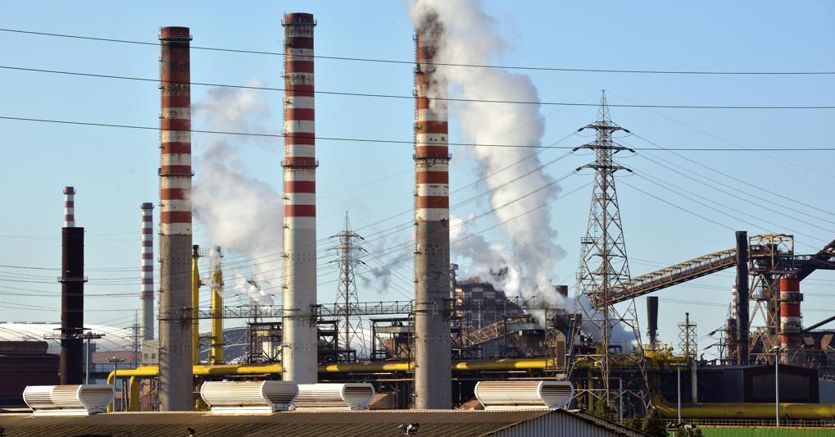After approval by the board of directors, the first sustainability report for 2021 of the Taranto plant of Acciaierie d’Italia, formerly Ilva, makes its debut. An analysis tool rich in data is back (the previous ones date back to the era of the Riva, owners and managers of the factory before the state commissioner in 2013 and the transfer to ArcelorMittal in 2017) and tells the leap from 2011, the year of the integrated authorization environmental (Hague) to 2019, 2020 with the sudden slowdown of Covid and the restart of 2021 after the pandemic and before the war.
Environmental data
One of the main data of the report concerns the environment and the emissions of the plant which, with the integral cycle and the hot area, has an impactful production. Compared to 2011, the year in which the Integrated Environmental Authorization was issued, the average of the three-year reporting period (from 2019 to 2021), writes the report, sees “a net reduction in emission values”. Taking the microgram per cubic meter of air as the unit of measurement, PM10 in fact goes from 37 in 2011 to 24.33 in the three-year period, while PM 2.5 from 19 to 11.67. On the other hand, benzoapyrene, which is one of the polycyclic aromatic hydrocarbons, drops to 0.18 nanograms per cubic meter of air. It started from 1.14. The numbers cited, detected at the monitoring station in via Machiavelli in the Tamburi district, measure the aerodynamic diameter of atmospheric particles, solid and liquid, suspended in ambient air. There are two public monitoring networks: one of AdI and the other of the Region. They are both managed by ARPA, the regional agency for environmental protection.
Better than Bolzano and Trieste
Legambiente also recognizes the improvements. But the Acciaierie d’Italia sustainability report also recalls the Legambiente report of 2022, “Mal’aria di città”, which examines the 2021 data, in terms of annual concentrations, of 232 monitoring stations from 102 provincial capitals . Legambiente focuses on the pollutants PM 10, PM 2.5 and nitrogen dioxide, considered by the scientific community to be the main indicators for measuring air quality. From the Legambiente dossier – reads the sustainability report of AdI – out of 102 cities sampled Taranto ranks in 65th place for PM10, with an average annual concentration of 21 micrograms per cubic meter of air while the limit set by the standard is 40. micrograms. A figure that is better than Alessandria, Palermo, Rome, breaking latest news, Rimini and many of the Italian cities.
For PM 2.5, Taranto is instead in 73rd place with 11 micrograms per cubic meter, an expected limit of 25 micrograms as an annual average. Better data than Bolzano and Trieste. Finally, for nitrogen dioxide Taranto is 35th out of 100 cities: here the measured value is 25 micrograms per cubic meter against the limit of 40 as an annual average. Dioxin and dust also decrease. Dioxin concentrations measured in annual averages also decreased. from chimney E312, the highest in the steel industry. It went from a value of 6.91 in 2011 to 0.07 in the three-year period 2019-2021. And again, dust, measured as mass flows, went from 8,320 tons per year, according to Hague 2011 data, to 760 tons per year on the 2019-2021 average. Sulfur oxides from 15,231 in 2021 to 4,859 of the 2019-2021 average. Nitrogen oxides from 14,169 to 4,521 of the three-year average. It is true that 2020 was a year of low production for the steel mill due to the pandemic, but the report also highlights that ongoing and planned investments in the environment amount to 1.77 billion. While a few months ago Ispra and the Ministry of Ecological Transition declared that “the interventions planned for the adaptation of the plants have been almost all completed and certified” and that “the execution of the remaining interventions is in line with the schedule”. It was then estimated “the post-operam emission scenario (ie the scenario following the implementation of the planned interventions) and relating to an annual production of 6 million tons of steel” and it emerged that “a significant reduction in dust emissions compared to the scenario ante-operam “.
Scrap and ferrous materials recovered
The report then provides other data relating to the environment. And it reveals that in 2021 279,209 tons of ferrous materials were recovered in Taranto, to which must be added 424,685 tons of recycled scrap. With this material 17.6 percent of steel was produced, a value calculated on the tons of net slabs and an increase compared to 2020 when the percentage was 16.6. On waste, however, the report shows that production in 2021 was equal to 1.767 million tons, of which 1.751 million non-hazardous and 15,869 hazardous. The factory has two landfills. Just over one million tons went to internal recovery, 258,596 tons to external recovery, 361,424 tons to internal disposal and 104,406 to external recovery.
